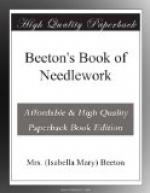ILLUSTRATIONS 86 & 87 (Button-holes and Eyelets).—This kind of embroidery is used only in round or long patterns. Trace first the outline of the hole, cut away a small round piece of material, not too close to the outlines (when the button-hole is very small merely insert the point of the scissors or a stiletto into the material), fold the edge of the material back with the needle, and work the hole in overcast stitch, inserting the needle into the empty place in the centre and drawing it out under the outline. Some button-holes are worked separately; sometimes they are in a row; if so, take care to begin to work each button-hole at the place where it touches the next. In the following button-holes the outside must be traced double, so as to reach as far as the next one, but each button-hole is finished at once. Illustration 86 shows a button-hole worked round in button-hole stitch, 87 an eyelet-hole worked in overcast.
[Illustration: 86.—Button and Eyelet Holes.]
[Illustration: 87.—Button and Eyelet Holes.]
[Illustration: 88.—Shaded Button-hole.]
[Illustration: 89.—Shaded Button-hole.]
ILLUSTRATIONS 88 & 89.—Shaded button-holes are worked like the others, only they are prepared, as can be seen in illustration 89, so as to mark the thickness. The stitches must gradually get narrower or wider, and be worked very close to each other.
[Illustration: 90.—Leaf in Raised Satin Stitch.]
ILLUSTRATIONS 90 & 91 (Two Leaves in Raised Satin Stitch).—In a leaf like the one seen in 90 work first the outline and veining in overcast stitch; work one half of the leaf in satin stitch, and the other half between the overcast outline and veining in back stitch. The stem of a leaf is always worked last.
[Illustration: 91.—Leaf in Raised Satin Stitch.]
[Illustration: 92.—Raised Leaf.]
ILLUSTRATIONS 92 & 93 (Two Leaves in Satin Stitch and Point de Plume).—For leaves like the one seen in 93 begin with the veinings, then work the inner points, then the outer ones, and lastly the raised spots in the centre. The leaf seen in 92 is worked, one half in point de plume, the other half in back stitch or point d’or.
[Illustration: 93.—Raised Leaf.]
[Illustration: 94.—Leaf.]
ILLUSTRATION 94.—– The outline of this leaf is embroidered in overcast stitch; the open-work veining consists of eyelets; one half of the leaf is worked in back stitch, the other half in a kind of satin stitch worked without chain stitches underneath; the stitches are worked across the leaf, leaving between two stitches an interval as wide as the stitch itself. The next row is then worked in these intervals, and each stitch begins half-way up the one before and after it.
[Illustration: 95.—Leaf Raised.]
[Illustration: 96.—Leaf Raised.]
[Illustration: 97.—Raised Leaf.]




